Dangerous Goods - Batteries
Overview
Whether a battery can be carried or not depends on its type, configuration, and Watt hour (Wh) rating.
Lithium-ion and Lithium Metal Batteries that are damaged or defective in accordance with SP A154 are prohibited from transport on Alliance Aircraft.
Step 1 – Determine the Battery Type:
- What is the battery used for? Is it rechargeable? Is it Lead Acid? Is it spillable? (Check the battery label)
Step 2 - Determine the Configuration and Quantity:
- Battery in equipment - Must be securely installed in the device and protected against inadvertent activation.
- Spare batteries - Batteries not installed in a device inc. power banks/packs. Must be protected against short circuit. This can be done by placing each battery in a separate plastic bag/protective pouch, or insulating terminals by taping over them.
Step 3 Calculate Watt hour (Wh) rating:
- Amp hours (Ah) x Voltage (v) = Watt Hours (Wh). Simply: Ah x v = Wh (Examples further down the page)
- milliAmp hour (mAh) x Voltage (v) \ 1000 = Watt Hours (Wh). Simply: mAh x V = ? divided by 1000 = Wh
Items exceeding the below specifications should be referred to an Air Cargo Agent to travel as Cargo.
All Lithium batteries must meet the requirements of UN Manual of Tests and Criteria, Part III, subsection 38.3.
For additional assistance please contact the Alliance Airlines Dangerous Goods Specialists via email: [email protected]
|
Type
|
Configuration & Quantities
|
Carry-on Baggage
|
Checked Baggage
|
Approval required
|
|
Dry Batteries
|
- AAA, AA, C, D, 9V
- Nickel Metal Hydride (NiMH), Nickel Cadmium (NiCad)
|
In equipment: Reasonable for personal use. Securely installed, device off and packed to prevent damage.
|

|

Recommend in carry-on
|
 * *
Yes, for more than 20
|
|
Spares: Total of 20 spare batteries permitted. Terminals must be protected from short circuit.
*Approval required to exceed total of 20.
|

|

|
|
Sealed lead-acid, non-spillable or gel type batteries 12v or less AND 100Wh or less.
|
Small toys, emergency lighting, small solar system etc.
|
In equipment: Reasonable for personal use. Securely installed, device off and packed to prevent damage.
|

|

|

|
|
Spares: Total of 2 (two) spare batteries permitted. Terminals must be protected from short circuit.
|

|

|
|
Lithium-ion (Li-ion) / Lithium-ion polymer (LiPo) 100Wh or less
AND/OR
Lithium metal 2g or less
|
Mobile phones, handheld devices, laptops, tablets, small power tools, cameras, small toys etc.
|
In equipment: Total of 15 PEDs.
Securely installed, device off and packed to prevent damage.
*Approval required to exceed total of 15.
|

|
 Recommend in carry-on Recommend in carry-on
|
 * *
Yes, for more than 15
|
|
Spares: Total of 15 spare batteries permitted.
*Approval required to exceed total of 15. Terminals must be protected from short circuit.
Vapes are PEDs & MUST travel in carry-on baggage ONLY.
|

|

|
|
Lithium-ion (Li-ion) / Lithium-ion polymer (LiPo) 101Wh to 160Wh
AND/OR
Lithium metal 2.1g to 8g restricted to medical devices only.
|
Batteries in larger camera equipment, power tools, drones etc.
Medical devices such as oxygen generators
|
In equipment: Reasonable for personal use. Securely installed, device off and packed to prevent damage.
|

|

|

|
|
Spares: Total of 2 (two) spare batteries permitted.
Terminals must be protected from short circuit.
|

|

|
|
POWER BANKS
Lithium-ion available in various sizes but not exceeding 160 Wh.
|
Power banks, UPS etc. Any portable battery pack that stores electrical energy to recharge electronic devices when away from a wall outlet.
|
Total of 2 (two) devices not exceeding 160 Wh.
Use in cabin is forbidden.
*Approval required if exceeds 100 Wh.
|

|

|

if exceeding 100Wh
|
|
Lithium-ion (Li-ion) / Lithium-ion polymer (LiPo) exceeding 160Wh
Lithium metal 8g+
AND/OR
Wet / spillable batteries.
|
Power banks, e-scooters, electric skateboards, other recreational devices.
Spillable batteries containing lead acid used in cars, boats, etc.
|
NOT PERMITTED
*Mobility Aid/Electric Wheelchair exemptions apply
|
Mobility Aid Batteries Only
Lithium Battery installed in a mobility aid:
- The installed battery terminals must be protected from short circuit (by being in an enclosed container or having exposed terminals protected.
- The battery must be securely attached to the mobility aid with all electrical circuits isolated.
- If the above cannot be achieved, the battery must be removed by the user.
Lithium Battery removed from and travelling with a mobility aid:
- A primary power Lithium battery removed from a mobility aid must not exceed 300Wh without Operator Approval which can be provided in accordance with a CASA Instrument. Two spare batteries may be carried for the mobility aid however these must not exceed 160Wh each.
- Lithium battery/batteries removed from a mobility aid must be carried by the passenger in the cabin.
- Lithium battery/batteries removed from a mobility aid must be protected from damage and short circuit.
Non-spillable Wet Batteries, Nickel-Metal Hydride Batteries or Dry Batteries installed in a mobility aid:
- The installed battery terminals must be protected from short circuit (by being in an enclosed container or having exposed terminals protected.
- The battery must be securely attached to the mobility aid with all electrical circuits isolated.
- If the above cannot be achieved, the battery must be removed by the user.
Non-spillable Wet Batteries, Nickel-Metal Hydride Batteries or Dry Batteries removed from and travelling with in a mobility aid:
- Must be packaged in strong rigid packaging which must be carried in the cargo hold.
- Passengers are permitted ONE spare wet, non-spillable battery OR two spare nickel-metal hydride batteries/dry batteries total.
Spillable Battery installed in the mobility aid:
- The installed battery must be protected from short circuit (by being in an enclosed container or having exposed terminals protected.
- The mobility aid must be switched off with wheels set in free motion.
Spillable Battery removed from the mobility aid:
- Battery must be packed in strong, rigid, leak proof packaging and protected against upset by way of being secured to a pallet.
- Battery must be protected against short circuit and surrounded by compatible absorbent material to absorb total liquid contents.
- Packaged battery must be marked with "BATTERY, WET, WITH WHEELCHAIR" or "BATTERY, WET WITH MOBILITY AID" and labelled with the "Corrosive" label and with the "Package Orientation" label.
Examples
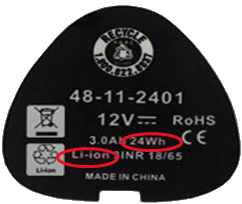 |
TYPE: This is a rechargeable Lithium-ion battery.
CONFIGURATION/QUANTITY: It is a single spare battery (not in equipment).
Watt Hour (Wh) Rating: 24Wh rating.
|
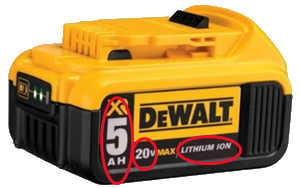 |
TYPE: This is a Lithium-ion battery
CONFIGURATION/QUANTITY: single spare battery
Watt Hour (Wh) Rating: It does not state Wh rating
It has a 5Ah rating and a 20V rating
5Ah x 20V = 100Wh
|
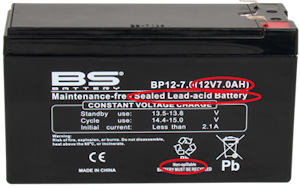 |
TYPE: This is a Sealed Lead-Acid Battery (SLA) identifying it is non-spillable.
CONFIGURATION/QUANTITY: single spare battery NOT travelling with a mobility aid
Watt Hour (Wh) Rating: It does not state Wh rating
It has a 12 V rating and a 7.0Ah rating
7.0Ah x 12V = 84Wh
|
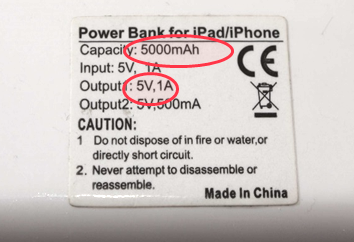 |
TYPE: This is a rechargeable lithium-ion battery.
CONFIGURATION/QUANTITY: Single spare battery
Watt Hour (Wh) Rating: It does not state its Wh rating.
It does not state an Ah rating.
It has a 5V rating and a 5000mAh rating
5000mAH x 5V = 25000/1000 = 25Wh
|
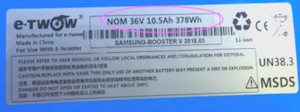 |
TYPE: This is a lithium battery removed from an electric scooter.
CONFIGURATION/QUANTITY: single spare battery
Watt Hour (Wh) Rating: It has a 36 V rating and a 10.5Ah rating and states that it is 378Wh
|